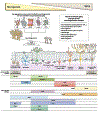Neurogenesis in aging and age-related neurodegenerative diseases
- PMID: 35490966
- PMCID: PMC9168971
- DOI: 10.1016/j.arr.2022.101636
Neurogenesis in aging and age-related neurodegenerative diseases
Abstract
Adult neurogenesis, the process by which neurons are generated in certain areas of the adult brain, declines in an age-dependent manner and is one potential target for extending cognitive healthspan. Aging is a major risk factor for neurodegenerative diseases and, as lifespans are increasing, these health challenges are becoming more prevalent. An age-associated loss in neural stem cell number and/or activity could cause this decline in brain function, so interventions that reverse aging in stem cells might increase the human cognitive healthspan. In this review, we describe the involvement of adult neurogenesis in neurodegenerative diseases and address the molecular mechanistic aspects of neurogenesis that involve some of the key aggregation-prone proteins in the brain (i.e., tau, Aβ, α-synuclein, …). We summarize the research pertaining to interventions that increase neurogenesis and regulate known targets in aging research, such as mTOR and sirtuins. Lastly, we share our outlook on restoring the levels of neurogenesis to physiological levels in elderly individuals and those with neurodegeneration. We suggest that modulating neurogenesis represents a potential target for interventions that could help in the fight against neurodegeneration and cognitive decline.
Keywords: Aging; Dentate gyrus; Hippocampus; Memory; Neurodegeneration; Neurogenesis.
Published by Elsevier B.V.
Figures


References
-
- Altman J, 2011. The Discovery of Adult Mammalian Neurogenesis, in: Seki T, Sawamoto K, Parent JM, Alvarez-Buylla A (Eds.), Neurogenesis in the Adult Brain I. Springer; Japan, Tokyo, pp. 3–46. doi:10.1007/978-4-431-53933-9_1 - DOI
Publication types
MeSH terms
Grants and funding
LinkOut - more resources
Full Text Sources
Other Literature Sources
Medical
Miscellaneous

